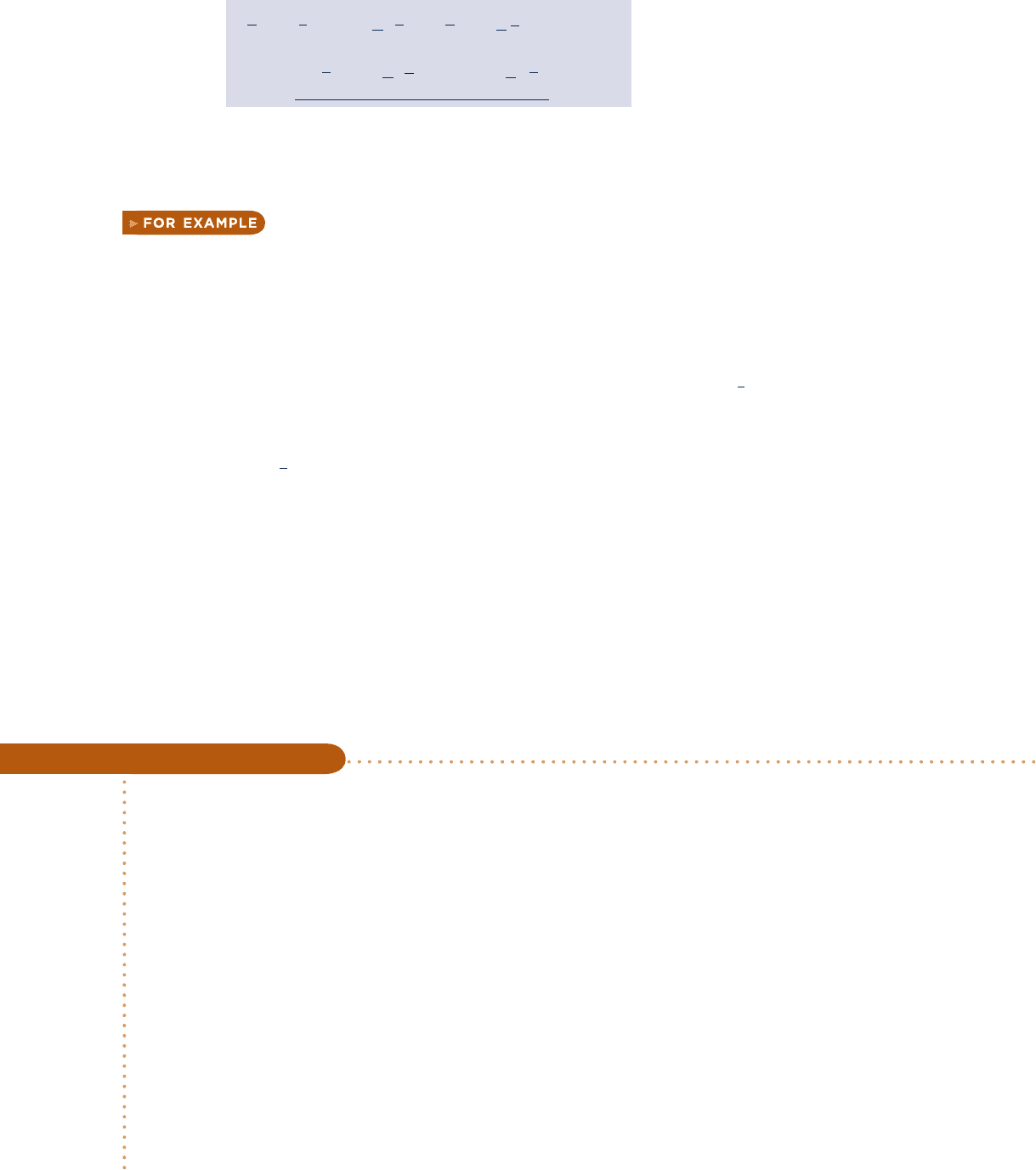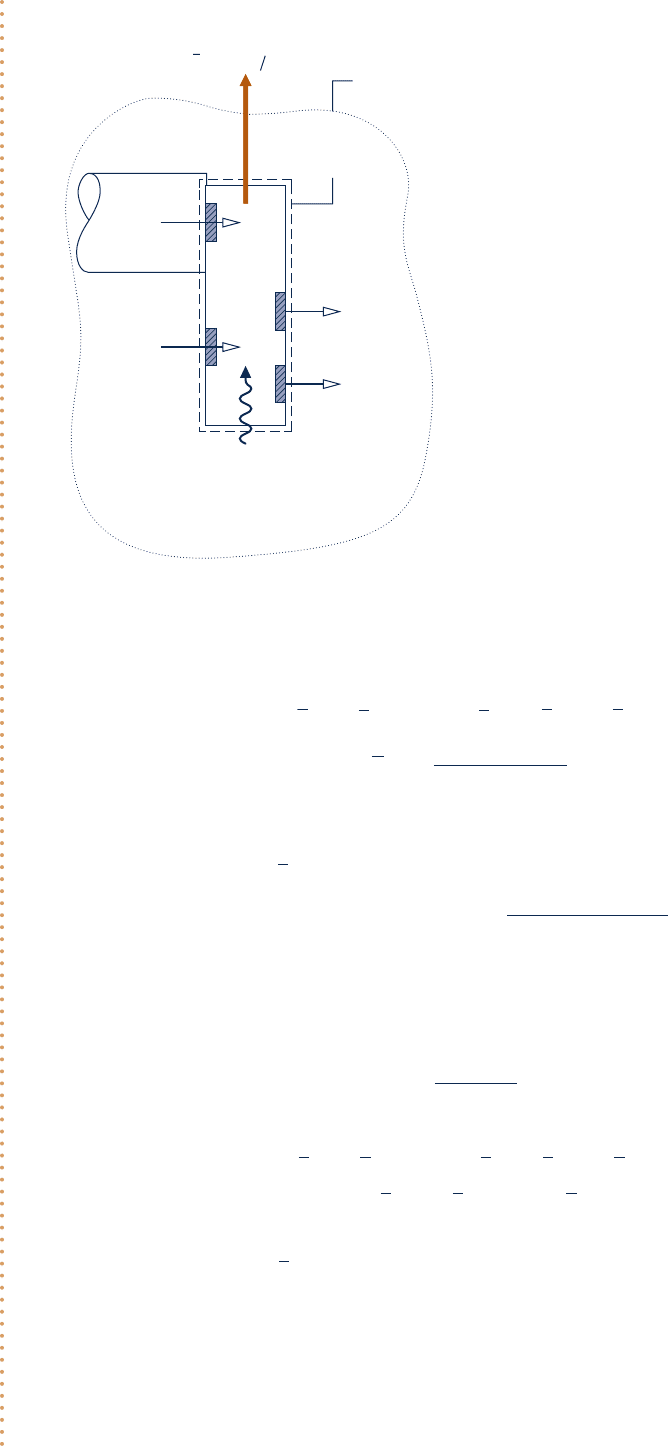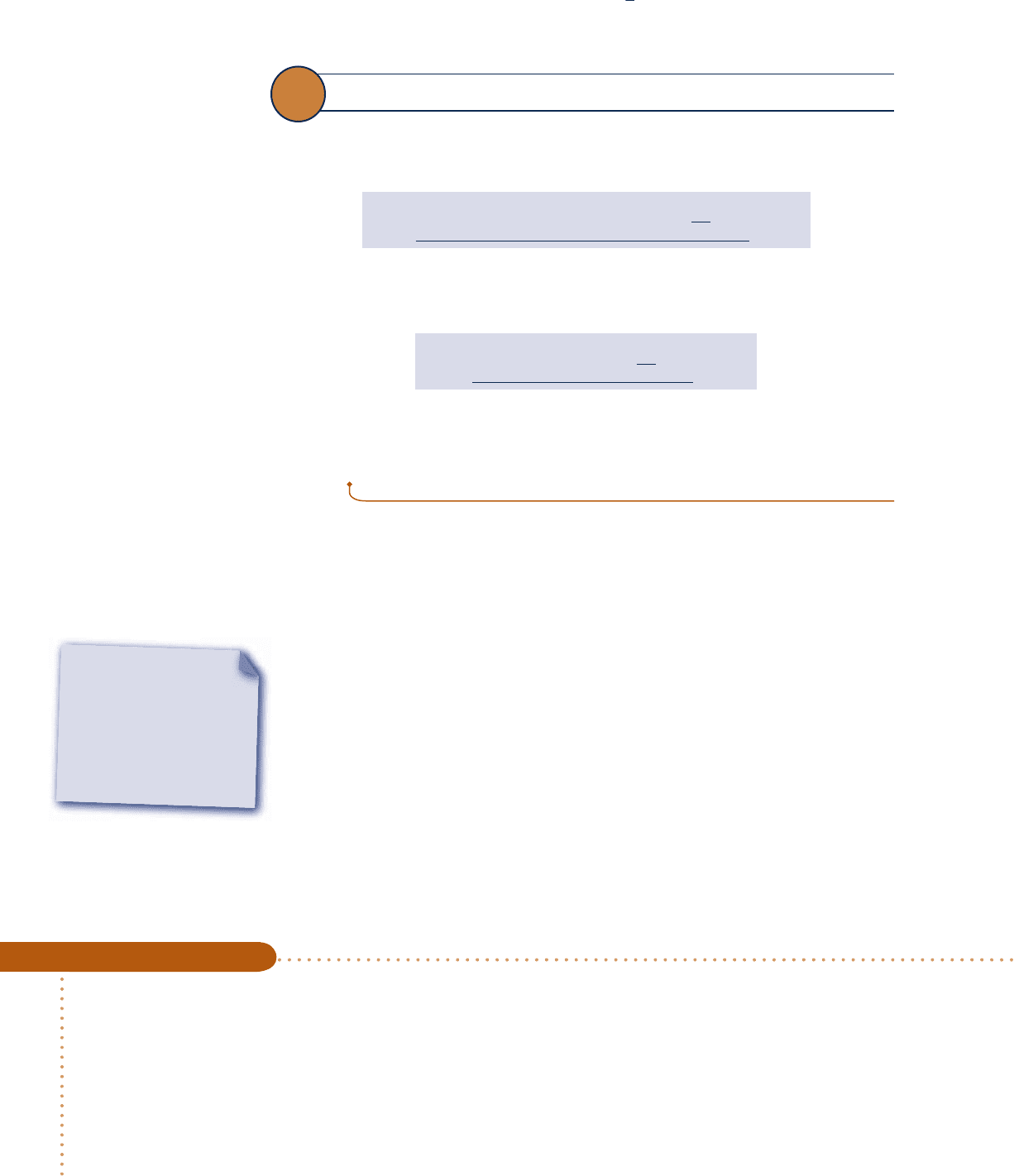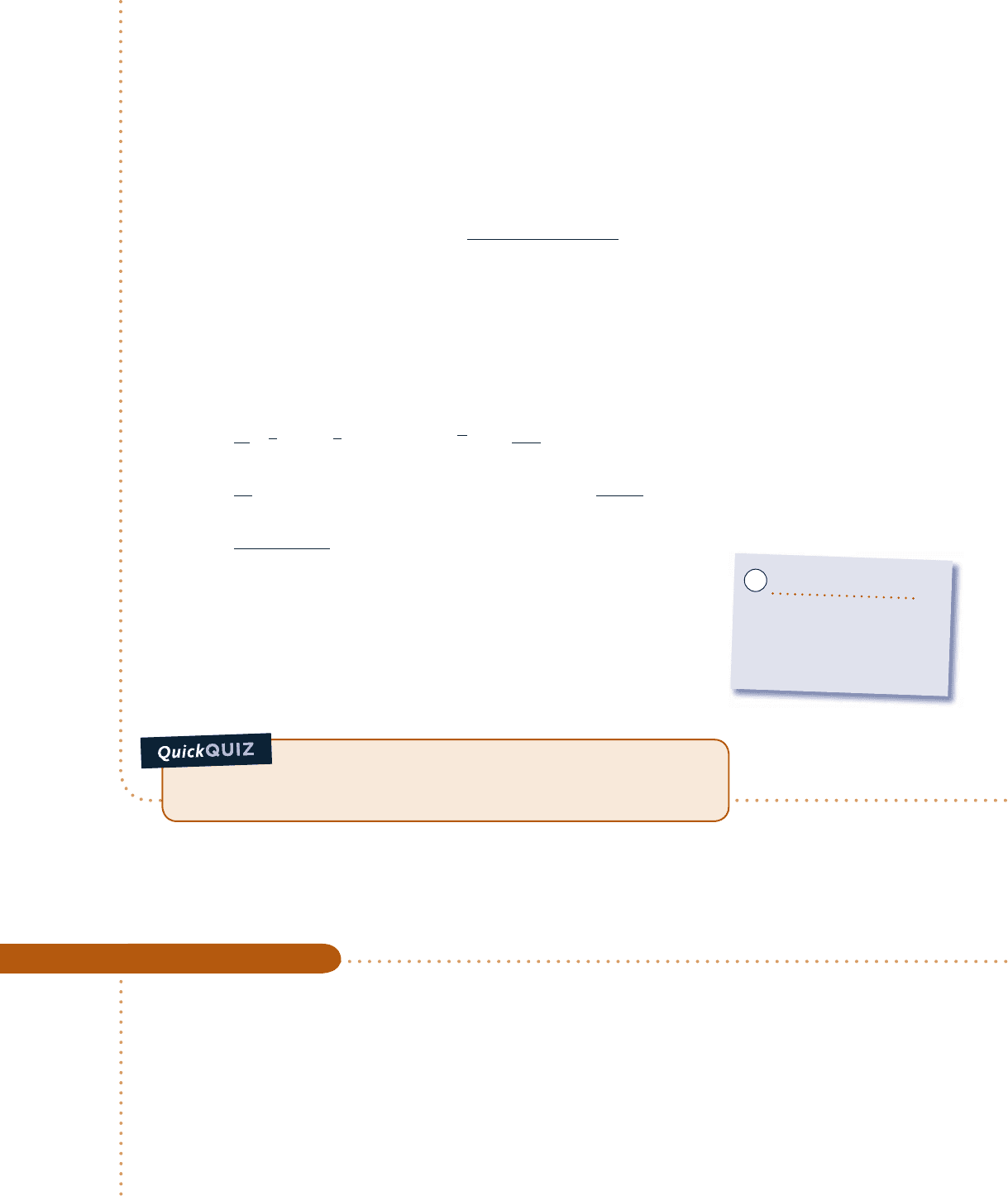Moran M.J., Shapiro H.N. Fundamentals of Engineering Thermodynamics
Подождите немного. Документ загружается.


Equations 13.42 and 13.43 can be expressed alternatively in terms of molar Gibbs
functions as follows
e
ch
F
5 c
g
F
1 aa 1
b
4
b
g
O
2
2 a
g
CO
2
2
b
2
g
H
2
O1l2
d1T
0
, p
0
2
1 ae
ch
CO
2
1 a
b
2
b
e
ch
H
2
O1l2
2 aa 1
b
4
b e
ch
O
2
(13.44b)
With Eqs. 13.44, the standard chemical exergy of the hydrocarbon C
a
H
b
can be calcu-
lated using the standard chemical exergies of O
2
, CO
2
, and H
2
O(l), together with selected
property data: the higher heating value and absolute entropies, or Gibbs functions.
consider the case of methane, CH
4
, and T
0
5 298.15 K (25°C), p
0
5
1 atm. For this application we can use Gibbs function data directly from Table A-25,
and standard chemical exergies for CO
2
, H
2
O(l), and O
2
from Table A-26 (Model II),
since each source corresponds to 298.15 K, 1 atm. With a 5 1, b 5 4, Eq. 13.44b gives
831,680 kJ/kmol. This agrees with the value listed for methane in Table A-26 for
Model II. b b b b b
We conclude the present discussion by noting special aspects of Eqs. 13.44:
c First, Eq. 13.44a requires the higher heating value and the absolute entropy s
F
.
When data from property compilations are lacking for these quantities, as in
the cases of coal, char, and fuel oil, the approach of Eq. 13.44a can be invoked
using a measured or estimated heating value and an estimated value of the
absolute entropy s
F
determined with procedures discussed in the literature.
2
c Next, note that the first term of Eq. 13.44b can be written more compactly as 2DG:
the negative of the change in Gibbs function for the reaction.
c Finally, note that only the underlined terms of Eqs. 13.44 require chemical exergy
data relative to the model selected for the exergy reference environment.
In Example 13.12 we compare the use of Eq. 13.36 and Eq. 13.44b for evaluating
the chemical exergy of a pure hydrocarbon fuel.
2
See, for example, A. Bejan, G. Tsatsaronis, and M. J. Moran, Thermal Design and Optimization,Wiley, New York,
1996, Secs. 3.4.3 and 3.5.4.
13.7 Standard Chemical Exergy 823
Evaluating the Chemical Exergy of Liquid Octane
c c c c EXAMPLE 13.12 c
Determine the chemical exergy of liquid octane at 258C, 1 atm, in kJ/kg. (a) Using Eq. 13.36, evaluate the
chemical exergy for an environment corresponding to Table 13.4—namely, a gas phase at 258C, 1 atm obeying
the ideal gas model with the following composition on a molar basis: N
2
, 75.67%; O
2
, 20.35%; H
2
O, 3.12%; CO
2
,
0.03%; other, 0.83%. (b) Evaluate the chemical exergy using Eq. 13.44b and standard chemical exergies from
Table A-26 (Model II). Compare each calculated exergy value with the standard chemical exergy for liquid octane
reported in Table A-26 (Model II).
SOLUTION
Known:
The fuel is liquid octane.
Find: Determine the chemical exergy (a) using Eq. 13.36 relative to an environment consisting of a gas phase at
258C, 1 atm with a specified composition, (b) using Eq. 13.44b and standard chemical exergies. Compare calcu-
lated values with the value reported in Table A-26 (Model II).
c13ReactingMixturesandCombustio823 Page 823 8/11/10 9:29:53 AM user-s146 c13ReactingMixturesandCombustio823 Page 823 8/11/10 9:29:53 AM user-s146 /Users/user-s146/Desktop/Merry_X-Mas/New/Users/user-s146/Desktop/Merry_X-Mas/New

824 Chapter 13
Reacting Mixtures and Combustion
Analysis: (a) Since a 5 8, b 5 18, c 5 0, Eq. 13.30 gives the following expression for the complete combustion
of liquid octane with O
2
C
8
H
1
8
1
l
2
1 12.5O
2
S
8CO
2
1 9H
2
O
1g2
Furthermore, Eq. 13.36 takes the form
e
c
h
5 3g
C
8
H
18
1l2
1 12.5g
O
2
2 8g
CO
2
2 9
g
H
2
O1g2
41T
0
, p
0
2
1
RT
0
ln c
1y
e
O
2
2
12.5
1y
e
CO
2
2
8
1y
e
H
2
O1g2
2
9
d
Since T
0
5 T
ref
and p
0
= p
ref
, the required specific Gibbs functions are just the Gibbs functions of formation from
Table A-25. With the given composition of the environment and data from Table A-25, the above equation gives
e
c
h
5
3
6610 1 12.5
1
0
2
2 8
1
2394,380
2
2 9
1
2228,590
24
1 8.3141298.152 ln c
10.20352
12.5
1
0.0003
2
8
1
0.0312
2
9
d
5 5,218,960 1 188,883 5 5,407,843 kJ
/
kmol
This value agrees closely with the standard chemical exergy for liquid octane reported in Table A-26 (Model II):
5,413,100 kJ/kmol.
Dividing by the molecular weight, the chemical exergy is obtained on a unit mass basis
e
ch
5
5,407,843
114.22
5 47,346 kJ
/
kg
(b) Using coefficients from the reaction equation above, Eq. 13.44b reads
e
c
h
5 3g
C
8
H
18
1l2
1 12.5g
O
2
2 8g
CO
2
2 9g
H
2
O1l2
41T
0
, p
0
2
1 8e
c
h
CO
2
1 9e
c
h
H
2
O1l2
2 12.5e
c
h
O
2
With data from Table A-25 and Model II of Table A-26, the above equation gives
e
c
h
5
3
6610 1 12.5
1
0
2
2 8
1
2394,380
2
2 9
1
2237,180
24
1 8
1
19,870
2
1 9
1
900
2
2 12.5
1
3970
2
5 5,296,270 1 117,435 5 5,413,705 kJ
/
kmol
Boundary of
overall system
Boundary of the
control volume
Heat transfer
with environment
C
8
H
18
at
T
0
, p
0
T
0
CO
2
at T
0
, y
CO
2
p
0
e
O
2
at T
0
, y
O
2
p
0
e
H
2
O at T
0
, y
H
2
O
p
0
e
e
ch
= (W
cv
n
F
)
max
·
·
Environment:
T
0
p
0
y
N
2
y
O
2
y
H
2
O
(g)
y
CO
2
e
e
e
e
= 25°C
= 1 atm
= 0.7567
= 0.2035
= 0.0312
= 0.0003
Fig. E13.12
Engineering Model: As shown in Fig. E13.12, the environment
for part (a) consists of an ideal gas mixture with the molar
analysis: N
2
, 75.67%; O
2
, 20.35%; H
2
O, 3.12%; CO
2
, 0.03%;
other, 0.83%. For part (b), Model II of Table A-26 applies.
Schematic and Given Data:
➊
➋
c13ReactingMixturesandCombustio824 Page 824 8/12/10 7:38:05 AM user-s146 c13ReactingMixturesandCombustio824 Page 824 8/12/10 7:38:05 AM user-s146 /Users/user-s146/Desktop/Merry_X-Mas/New/Users/user-s146/Desktop/Merry_X-Mas/New

13.7.2
Standard Chemical Exergy of Other Substances
By paralleling the development given in Sec. 13.7.1 leading to Eq. 13.44b, we can in
principle determine the standard chemical exergy of any substance not present in the
environment. With such a substance playing the role of C
a
H
b
in the previous develop-
ment, we consider a reaction of the substance with other substances for which the
standard chemical exergies are known, and write
e
ch
52¢G 1
a
P
ne
ch
2
a
R
ne
ch
(13.45)
where DG is the change in Gibbs function for the reaction, regarding each substance
as separate at temperature T
0
and pressure p
0
. The underlined term corresponds to
the underlined term of Eq. 13.44b and is evaluated using the known standard chem-
ical exergies, together with the n’s giving the moles of these reactants and products
per mole of the substance whose chemical exergy is being evaluated.
consider the case of ammonia, NH
3
, and T
0
5 298.15 K (258C),
p
0
5 1 atm. Letting NH
3
play the role of C
a
H
b
in the development leading to Eq. 13.44b,
we can consider any reaction of NH
3
with other substances for which the standard
chemical exergies are known. For the reaction
NH
3
1
3
4
O
2
S
1
2
N
2
1
3
2
H
2
O
1
l
2
Eq. 13.45 takes the form
e
ch
NH
3
5 3g
NH
3
1
3
4
g
O
2
2
1
2
g
N
2
2
3
2
g
H
2
O1l2
41T
0
, p
0
2
1
1
2
e
ch
N
2
1
3
2
e
ch
H
2
O1l2
2
3
4
e
ch
O
2
Would the higher heating value (HHV) of liquid octane provide
a plausible estimate of the chemical exergy in this case? Ans. Yes, Table
A-25 gives 47,900 kJ/kg, which is approximately 1% greater than values
obtained in parts (a) and (b).
As expected, this agrees closely with the value listed for octane in Table A-26 (Model II): 5,413,100 kJ/kmol.
Dividing by the molecular weight, the chemical exergy is obtained on a unit mass basis
e
ch
5
5,413,705
114.22
5 47,397 kJ
/
kg
The chemical exergies determined with the two approaches used in parts (a) and
(b) also closely agree.
➊
A molar analysis of this environment on a dry basis reads: O
2
: 21%, N
2
, CO
2
and the other dry components: 79%. This is consistent with the dry air analy-
sis used throughout the chapter. The water vapor present in the assumed envi-
ronment corresponds to the amount of vapor that would be present were the
gas phase saturated with water at the specified temperature and pressure.
➋
The value of the logarithmic term of Eq. 13.36 depends on the composition
of the environment. In the present case, this term contributes about 3% to
the magnitude of the chemical exergy. The contribution of the logarithmic
term is usually small. In such instances, a satisfactory approximation to the
chemical exergy can be obtained by omitting the term.
Ability to…
❑
calculate the chemical
exergy of a hydrocarbon
fuel relative to a specified
reference environment.
❑
calculate the chemical
exergy of a hydrocarbon
fuel based on standard
chemical exergies.
✓
Skills Developed
13.7 Standard Chemical Exergy 825
c13ReactingMixturesandCombustio825 Page 825 7/13/10 11:42:16 AM user-s146 c13ReactingMixturesandCombustio825 Page 825 7/13/10 11:42:16 AM user-s146 /Users/user-s146/Desktop/Merry_X-Mas/New/Users/user-s146/Desktop/Merry_X-Mas/New

826 Chapter 13 Reacting Mixtures and Combustion
Using Gibbs function data from Table A-25, and standard chemical exergies for O
2
,
N
2
, and H
2
O(l) from Table A-26 (Model II),
e
c
h
NH
3
5 337,910 kJ/kmol. This agrees
closely with the value for ammonia listed in Table A-26 for Model II. b b b b b
total exergy
total flow exergy
13.8 Applying Total Exergy
The exergy associated with a specified state of a system is the sum of two contribu-
tions: the thermomechanical contribution introduced in Chap. 7 and the chemical
contribution introduced in this chapter. On a unit mass basis, the total exergy is
e 5 1u 2 u
0
21 p
0
1y 2 y
0
22 T
0
1s 2 s
0
21
V
2
2
1 gz 1 e
ch
(13.46)
where the underlined term is the thermomechanical contribution (Eq. 7.2) and e
ch
is
the chemical contribution evaluated as in Sec. 13.6 or 13.7. Similarly, the total flow
exergy
associated with a specified state is the sum
e
f
5 h 2 h
0
2 T
0
1s 2 s
0
21
V
2
2
1 gz 1 e
ch
(13.47)
where the underlined term is the thermomechanical contribution (Eq. 7.14) and e
ch
is the chemical contribution.
13.8.1
Calculating Total Exergy
Exergy evaluations considered in previous chapters of this book have been alike in
this respect: Differences in exergy or flow exergy between states of the same compo-
sition have been evaluated. In such cases, the chemical exergy contribution cancels,
leaving just the difference in thermomechanical contributions to exergy. However, for
many evaluations it is necessary to account explicitly for chemical exergy—for instance,
chemical exergy is important when evaluating processes involving combustion.
When using Eqs. 13.46 and 13.47 to evaluate total exergy at a state, we first think
of bringing the system from that state to the state where the system is in thermal and
mechanical equilibrium with the environment—that is, to the dead state where tem-
perature is T
0
and pressure is p
0
. In applications dealing with gas mixtures involving
water vapor, such as combustion products of hydrocarbons, some condensation of
water vapor to liquid normally will occur in any such process to the dead state. Thus,
at the dead state the initial gas mixture consists of a gas phase containing water vapor
plus a relatively small amount of liquid water. Still, to simplify total exergy evalua-
tions we will assume at the dead state that all water present in the combustion prod-
ucts of hydrocarbons exists only in vapor form. This hypothetical dead state condition
suffices for applications considered in this chapter.
In Examples 13.13 and 13.14 to follow, we illustrate the evaluation of total exergy
using the principles developed in Sec. 13.6. In Example 13.13, Eq. 13.47 is applied to
evaluate the total specific flow exergy of a steam leak.
TAKE NOTE...
To simplify total exergy
evaluations, combustion
products at the dead
state are assumed to
contain water only as a
vapor.
Evaluating the Total Flow Exergy of a Steam Leak
c c c c EXAMPLE 13.13 c
Steam at 5 bar, 2408C leaks from a line in a vapor power plant. Evaluate the total flow exergy of the steam, in
kJ/kg, relative to an environment consisting of an ideal gas mixture at 258C, 1 atm in which the mole fraction of
water vapor is y
e
H
2
O
5 0.0250. Neglect the effects of motion and gravity.
c13ReactingMixturesandCombustio826 Page 826 7/13/10 11:42:18 AM user-s146 c13ReactingMixturesandCombustio826 Page 826 7/13/10 11:42:18 AM user-s146 /Users/user-s146/Desktop/Merry_X-Mas/New/Users/user-s146/Desktop/Merry_X-Mas/New

If the mass flow rate of the steam leak is 0.07 kg/s, and the
flow exergy is valued at $0.10/kW ? h, what is the value of one day’s steam
loss? Ans. $138/day.
SOLUTION
Known:
Water vapor at a known state is specified. The environment is also described.
Find: Determine the total flow exergy of the water vapor, in kJ/kg.
Engineering Model:
1.
The environment consists of a gas phase at T
0
5 258C, p
0
5 1 atm that obeys the ideal gas model. The mole
fraction of water vapor in the environment is 0.0250.
2. Neglect the effects of motion and gravity.
Analysis: With assumption 2, the total specific flow exergy is given by Eq. 13.47 as
e
f
5 1h 2 h
0
22 T
0
1s 2 s
0
21 e
ch
The underlined term is the thermomechanical contribution to the flow exergy, evaluated as in Chap. 7. With
data from the steam tables, and noting that water is a liquid at T
0
, p
0
h 2 h
0
2 T
0
1s 2 s
0
25 12939.9 2 104.922 29817.2307 2 0.36742
5 789.7 kJ
/
kg
where h
0
and s
0
are approximated as the saturated liquid values at T
0
.
The chemical exergy contribution to the flow exergy relative to the specified environment is evaluated using
Eq. 13.39. With data from Table A-25 and applying the molar mass to convert to a mass basis
e
ch
5
1
M
e3g
H
2
O1l2
2 g
H
2
O1g2
41T
0
, p
0
21 RT
0
ln a
1
y
e
H
2
O
bf
5
1
18
e32237,180 2 12228,590241 18.314212982 ln a
1
0.0250
bf
5
549.5 kJ
/
kmol
18 kg
/
kmol
5 30.5 kJ
/
kg
Adding the thermomechanical and chemical contributions, the flow exergy of
steam at the specified state is
e
f
5 789.7 1 30.5 5 820.2 kJ
/
kg
In this case, the chemical exergy contributes about 4% to the total flow exergy
magnitude.
Ability to…
❑
determine the flow exergy,
including the chemical exergy
contribution, of steam.
✓
Skills Developed
In Example 13.14, the total specific flow exergy of combustion products is evaluated.
Evaluating the Total Flow Exergy of Combustion Products
c c c c EXAMPLE 13.14 c
Methane gas enters a reactor and burns completely with 140% theoretical air. Combustion products exit as a mixture
at temperature T and a pressure of 1 atm. For T 5 865 and 28208R, evaluate the total specific flow exergy of the
combustion products, in Btu per lbmol of fuel. Perform calculations relative to an environment consisting of an ideal
gas mixture at 778F, 1 atm with the molar analysis, y
e
N
2
5 0.7567, y
e
O
2
5 0.2035, y
e
H
2
O
5 0.0303, y
e
CO
2
5 0.0003.
13.8 Applying Total Exergy
827
c13ReactingMixturesandCombusti827 Page 827 7/14/10 10:30:08 AM user-s146 c13ReactingMixturesandCombusti827 Page 827 7/14/10 10:30:08 AM user-s146 /Users/user-s146/Desktop/Merry_X-Mas/New/Users/user-s146/Desktop/Merry_X-Mas/New

828 Chapter 13 Reacting Mixtures and Combustion
SOLUTION
Known:
Methane gas reacts completely with 140% of the theoretical amount of air. Combustion products exit
the reactor at 1 atm and a specified temperature. The environment is also specified.
Find: Determine the total flow exergy of the combustion products, in Btu per lbmol of fuel, for each of two given
temperatures.
Engineering Model:
1.
The combustion products are modeled as an ideal gas mixture at all states considered.
2. The environment consists of an ideal gas mixture at T
0
5 778F, p
0
5 1 atm with a specified molar analysis.
3. Neglect the effects of motion and gravity.
Analysis: For 140% theoretical air, the reaction equation for complete combustion of methane is
CH
4
1 2.81O
2
1 3.76N
2
2
S
CO
2
1 2H
2
O 1 10.53N
2
1 0.8O
2
The total specific flow exergy is given by Eq. 13.47, which involves chemical and thermomechanical
contributions. Since the combustion products form an ideal gas mixture when at
T
0
,
p
0
(assumption 1) and each
component is present within the environment, the chemical exergy contribution, per mole of fuel, is obtained
from the following expression patterned after Eq. 13.41a
e
ch
5 RT
0
c1 ln a
y
CO
2
y
e
CO
2
b1 2 ln a
y
H
2
O
y
e
H
2
O
b1 10.53 ln a
y
N
2
y
e
N
2
b1 0.8 ln a
y
O
2
y
e
O
2
bd
From the reaction equation, the mole fractions of the components of the products are y
CO
2
5 0.0698, y
H
2
O
5 0.1396,
y
N
2
5 0.7348, y
O
2
5 0.0558. Substituting these values together with the respective environmental mole fractions,
we obtain e
ch
5 7637 Btu per lbmol of fuel.
Applying ideal gas mixture principles from Table 13.1, the thermomechanical contribution to the flow exergy,
per mole of fuel, is
h 2 h
0
2 T
0
1s 2 s
0
25 3h1T22 h1T
0
22 T
0
1s81T22 s81T
0
22 R ln 1y
CO
2
p
/
y
CO
2
p
0
224
CO
2
1 23h1T22 h1T
0
22 T
0
1s81T22 s81T
0
22 R ln 1y
H
2
O
p
/
y
H
2
O
p
0
224
H
2
O
1 10.533h1T22 h1T
0
22 T
0
1s81T22 s81T
0
22 R ln 1y
N
2
p
/
y
N
2
p
0
224
N
2
1 0.83h1T22 h1T
0
22 T
0
1s81T22 s81T
0
22 R ln 1y
O
2
p
/
y
O
2
p
0
224
O
2
Since p 5 p
0
, each of the logarithm terms drop out, and with
h
and s8 data at T
0
from Table A-23E, the ther-
momechanical contribution reads
h 2 h
0
2 T
0
1s 2 s
0
25 3h1T22 4027.5 2 5371s81T22 51.03224
CO
2
1 23h1T22 4258 2 5371s81T22 45.07924
H
2
O
1 10.533h1T22 3729.5 2 5371s81T22 45.74324
N
2
1 0.83h1T22 3725.1 2 5371s81T22 48.98224
O
2
Then, with
h
and s8 from Table A-23E at T 5 865 and 28208R, respectively, the following results are obtained
T 5 8658R: h 2 h
0
2 T
0
1s 2 s
0
25 7622 Btu per lbmol of fuel
T 5 28208R: h 2 h
0
2 T
0
1s 2 s
0
25 169,319 Btu per lbmol of fuel
Adding the two contributions, the total specific flow exergy of the combustion products at each of the speci-
fied states is
➋ T 5 8658R: e
f
5 15,259 Btu per lbmol of fuel
T 5 28208R: e
f
5 176,956 Btu per lbmol of fuel
➊ This assumes a hypothetical dead state condition. Although condensation of some of the water vapor present
in the combustion products would occur were the products brought to T
0
, p
0
, we assume for simplicity that
all water remains a vapor at the dead state. An exergy evaluation explicitly taking such condensation into
➊
c13ReactingMixturesandCombusti828 Page 828 8/11/10 9:26:37 AM user-s146 c13ReactingMixturesandCombusti828 Page 828 8/11/10 9:26:37 AM user-s146 /Users/user-s146/Desktop/Merry_X-Mas/New/Users/user-s146/Desktop/Merry_X-Mas/New

account is considered in Bejan, Tsatsaronis, and Moran, Thermal Design and
Optimization, p. 129, p. 138.
➋ The chemical contribution to the flow exergy is relatively unimportant in the
higher-temperature case, amounting only to about 4% of the flow exergy. Chem-
ical exergy accounts for about half of the exergy in the lower-temperature case,
however.
If fuel enters with a mass flow rate of 28 lb/h, determine the
flow exergy rate of the exiting combustion gases at T 5 28208R, in Btu/h
and kW. Ans. 3.1 3 10
5
Btu/h, 90.8 kW.
Ability to…
❑
determine the flow exergy,
including the chemical exergy
contribution, of gaseous
products of combustion.
✓Skills Developed
13.8.2
Calculating Exergetic Efficiencies of Reacting Systems
Devices designed to do work by utilization of a combustion process, such as vapor
and gas power plants and reciprocating internal combustion engines, invariably have
irreversibilities and losses associated with their operation. Accordingly, actual devices
produce work equal to only a fraction of the maximum theoretical value that might
be obtained. The vapor power plant exergy analysis of Sec. 8.6 and the combined
cycle exergy analysis of Example 9.12 provide illustrations.
The performance of devices whose primary function is to do work can be evaluated
as the ratio of the actual work developed to the exergy of the fuel consumed in pro-
ducing that work. This ratio is an exergetic efficiency. The relatively low exergetic
efficiency exhibited by many common power-producing devices suggests that thermo-
dynamically more thrifty ways of utilizing the fuel to develop power might be possible.
However, efforts in this direction must be tempered by the economic imperatives that
govern the practical application of all devices. The trade-off between fuel savings and
the additional costs required to achieve those savings must be carefully weighed.
The fuel cell provides an illustration of a relatively fuel-efficient device. We noted
previously (Sec. 13.4) that the chemical reactions in fuel cells are more controlled
than the rapidly occurring, highly irreversible combustion reactions taking place in
conventional power-producing systems. In principle, fuel cells can achieve greater
exergetic efficiencies than many such devices. Still, relative to conventional power
systems, fuel cell systems typically cost more per unit of power generated, and this
has limited their deployment.
The examples to follow illustrate the evaluation of an exergetic efficiency for an
internal combustion engine and a reactor. In each case, standard chemical exergies
are used in the solution.
Evaluating Exergetic Efficiency of an Internal Combustion Engine
c c c c EXAMPLE 13.15 c
Devise and evaluate an exergetic efficiency for the internal combustion engine of Example 13.4. For the fuel,
use the standard chemical exergy value from Table A-26 (Model II).
SOLUTION
Known:
Liquid octane and the theoretical amount of air enter an internal combustion engine operating at steady
state in separate streams at 778F, 1 atm, and burn completely. The combustion products exit at 11408F. The power
developed by the engine is 50 horsepower, and the fuel mass flow rate is 0.004 lb/s.
Find: Devise and evaluate an exergetic efficiency for the engine using the fuel standard chemical exergy value
from Table A-26 (Model II).
13.8 Applying Total Exergy 829
c13ReactingMixturesandCombusti829 Page 829 7/13/10 11:43:08 AM user-s146 c13ReactingMixturesandCombusti829 Page 829 7/13/10 11:43:08 AM user-s146 /Users/user-s146/Desktop/Merry_X-Mas/New/Users/user-s146/Desktop/Merry_X-Mas/New

830 Chapter 13 Reacting Mixtures and Combustion
Schematic and Given Data: See Fig. E13.4.
Engineering Model:
1.
See the assumptions listed in the solution to Example 13.4.
2. The environment corresponds to Model II of Table A-26.
3. The combustion air enters at the condition of the environment.
Analysis: An exergy balance can be used in formulating an exergetic efficiency for the engine: At steady state,
the rate at which exergy enters the engine equals the rate at which exergy exits plus the rate at which exergy is
destroyed within the engine. As the combustion air enters at the condition of the environment, and thus with
zero exergy, exergy enters the engine only with the fuel. Exergy exits the engine accompanying heat and work,
and with the products of combustion.
If the power developed is taken to be the product of the engine, and the heat transfer and exiting product
gas are regarded as losses, an exergetic efficiency expression that gauges the extent to which the exergy entering
the engine with the fuel is converted to the product is
➊
e 5
W
#
cv
E
#
F
where E
#
F
denotes the rate at which exergy enters with the fuel.
Since the fuel enters the engine at 778F and 1 atm, which correspond to the values of T
0
and p
0
of the envi-
ronment, and kinetic and potential energy effects are negligible, the exergy of the fuel is just the chemical exergy.
There is no thermomechanical contribution. Thus, with data from Table A-1 and Table A-26 (Model II)
E
#
F
5 m
#
F
e
ch
5 a0.004
lb
s
b a
5,413,100 kJ
/
kmol
114.22 kg
/
kmol
b`
Btu
/
lb
2.326 kJ
/
kg
`5 81.5
Btu
s
The exergetic efficiency is then
e 5 a
50 h
p
81.5 Btu
/
s
b`
2545 Btu
/
h
1 hp
``
1 h
3600 s
`5 0.434 143.4%2
➊ The exergy of exhaust gas and engine coolant of internal combustion engines
may be utilizable for various purposes—for instance, additional power might
be produced using bottoming cycles as considered in Problem 9.12D. In most
cases, such additional power would be included in the numerator of the
exergetic efficiency expression. Since a greater portion of the entering fuel
exergy is utilized in such arrangements, the value of e would be greater than
that evaluated in the solution.
Using a rationale paralleling that for the internal combustion
engine, devise and evaluate an exergetic efficiency for the gas turbine
power plant of Example 13.5. Ans. 0.332 (33.2%).
Ability to…
❑
devise and evaluate an
exergetic efficiency for an
internal combustion engine.
✓
Skills Developed
In the next example, we evaluate an exergetic efficiency for a reactor. In this case, the
exergy of the combustion products, not power developed, is the valued output.
Evaluating Exergetic Efficiency of a Reactor Fueled by Liquid Octane
c c c c EXAMPLE 13.16 c
For the reactor of Examples 13.8 and 13.9, determine the exergy destruction, in kJ per kmol of fuel, and devise
and evaluate an exergetic efficiency. Consider two cases: complete combustion with the theoretical amount of
air, and complete combustion with 400% theoretical air. For the fuel, use the standard chemical exergy value
from Table A-26 (Model II).
c13ReactingMixturesandCombusti830 Page 830 8/12/10 7:38:58 AM user-s146 c13ReactingMixturesandCombusti830 Page 830 8/12/10 7:38:58 AM user-s146 /Users/user-s146/Desktop/Merry_X-Mas/New/Users/user-s146/Desktop/Merry_X-Mas/New

SOLUTION
Known:
Liquid octane and air, each at 258C and 1 atm, burn completely in a well-insulated reactor operating at
steady state. The products of combustion exit at 1 atm pressure.
Find: Determine the exergy destruction, in kJ per kmol of fuel, and evaluate an exergetic efficiency for complete
combustion with the theoretical amount of air and 400% theoretical air.
Schematic and Given Data: See Fig. E13.9.
Engineering Model:
1.
See assumptions listed in Examples 13.8 and 13.9.
2. The environment corresponds to Model II of Table A-26.
3. The combustion air enters at the condition of the environment.
Analysis: An exergy rate balance can be used in formulating an exergetic efficiency: At steady state, the rate at
which exergy enters the reactor equals the rate at which exergy exits plus the rate at which exergy is destroyed
within the reactor. Since the combustion air enters at the condition of the environment, and thus with zero exergy,
exergy enters the reactor only with the fuel. The reactor is well insulated, so there is no exergy transfer accom-
panying heat transfer. There is also no work W
#
cv
. Accordingly, exergy exits only with the combustion products,
which is the valuable output in this case. The exergy rate balance then reads
E
#
F
5 E
#
products
1 E
#
d
(a)
where E
#
F
is the rate at which exergy enters with the fuel, E
#
products
is the rate at which exergy exits with the com-
bustion products, and E
#
d
is the rate of exergy destruction within the reactor.
An exergetic efficiency then takes the form
e 5
E
#
products
E
#
F
(b)
The rate at which exergy exits with the products can be evaluated with the approach used in the solution to
Example 13.14. But in the present case effort is saved with the following approach: Using the exergy balance for
the reactor, Eq. (a), the exergetic efficiency expression, Eq. (b), can be written alternatively as
e 5
E
#
F
2 E
#
d
E
#
F
5 1 2
E
#
d
E
#
F
(c)
The exergy destruction term appearing in Eq. (b) can be found from the relation
E
d
#
n
#
F
5 T
0
s
#
cv
n
#
F
where T
0
is the temperature of the environment and s
#
cv
is the rate of entropy production. The rate of entropy
production is evaluated in the solution to Example 13.9 for each of the two cases. For the case of complete
combustion with the theoretical amount of air
E
d
#
n
#
F
5 1298 K2 a5404
kJ
kmol ? K
b5 1,610,392
kJ
kmol
Similarly, for the case of complete combustion with 400% of the theoretical amount of air
E
d
#
n
#
F
5 129821975425 2,906,692
kJ
kmol
Since the fuel enters the reactor at 258C, 1 atm, which correspond to the values of T
0
and p
0
of the environ-
ment, and kinetic and potential effects are negligible, the exergy of the fuel is just the standard chemical exergy
from Table A-26 (Model II): 5,413,100 kJ
/
kmol. There is no thermomechanical contribution. Thus, for the case of
complete combustion with the theoretical amount of air, Eq. (c) gives
e 5 1 2
1,610,392
5,413,100
5 0.703 170.3%2
13.8 Applying Total Exergy 831
c13ReactingMixturesandCombusti831 Page 831 7/13/10 11:43:10 AM user-s146 c13ReactingMixturesandCombusti831 Page 831 7/13/10 11:43:10 AM user-s146 /Users/user-s146/Desktop/Merry_X-Mas/New/Users/user-s146/Desktop/Merry_X-Mas/New

832 Chapter 13 Reacting Mixtures and Combustion
In this chapter we have applied the principles of thermodynamics
to systems involving chemical reactions, with emphasis on sys-
tems involving the combustion of hydrocarbon fuels. We also
have extended the notion of exergy to include chemical exergy.
The first part of the chapter begins with a discussion of
concepts and terminology related to fuels, combustion air, and
products of combustion. The application of energy balances to
reacting systems is then considered, including control volumes
at steady state and closed systems. To evaluate the specific
enthalpies required in such applications, the enthalpy of for-
mation concept is introduced and illustrated. The determina-
tion of the adiabatic flame temperature is considered as an
application.
The use of the second law of thermodynamics is also dis-
cussed. The absolute entropy concept is developed to provide
the specific entropies required by entropy balances for systems
involving chemical reactions. The related Gibbs function of for-
mation concept is introduced. The first part of the chapter also
includes a discussion of fuel cells.
In the second part of the chapter, we extend the exergy con-
cept of Chap. 7 by introducing chemical exergy. The standard
chemical exergy concept is also discussed. Means are developed
and illustrated for evaluating the chemical exergies of hydrocar-
bon fuels and other substances. The presentation concludes with
a discussion of exergetic efficiencies of reacting systems.
The following list provides a study guide for this chapter.
When your study of the text and end-of-chapter exercises has
been completed, you should be able to
c
write out the meaning of the terms listed in the margin
throughout the chapter and understand each of the related
concepts. The subset of key concepts listed below is particu-
larly important.
c
determine balanced reaction equations for the combustion of
hydrocarbon fuels, including complete and incomplete com-
bustion with various percentages of theoretical air.
c
apply energy balances to systems involving chemical reac-
tions, including the evaluation of enthalpy using Eq. 13.9 and
the evaluation of the adiabatic flame temperature.
c
apply entropy balances to systems involving chemical reac-
tions, including the evaluation of the entropy produced.
c
evaluate the chemical exergy of hydrocarbon fuels and other
substances using Eqs. 13.35 and 13.36, as well as the stan-
dard chemical exergy using Eqs. 13.44 and 13.45.
c
evaluate total exergy using Eqs. 3.46 and 3.47.
c
apply exergy analysis, including chemical exergy and the
evaluation of exergetic efficiencies.
c CHAPTER SUMMARY AND STUDY GUIDE
c KEY ENGINEERING CONCEPTS
complete combustion, p. 778
air–fuel ratio, p. 779
theoretical air, p. 780
percent of theoretical air, p. 780
dry product analysis, p. 783
enthalpy of formation, p. 788
heating values, p. 797
adiabatic flame temperature, p. 800
fuel cell, p. 804
absolute entropy, p. 809
chemical exergy, p. 816
standard chemical exergy, p. 821
Similarly, for the case of complete combustion with 400% of the theoretical amount of air, we get
e 5 1 2
2,906,692
5,413,100
5 0.463 146.3%2
➊ The calculated efficiency values show that a substantial portion of the fuel
exergy is destroyed in the combustion process. In the case of combustion
with the theoretical amount of air, about 30% of the fuel exergy is destroyed.
In the excess air case, over 50% of the fuel exergy is destroyed. Further
exergy destructions would take place as the hot gases are utilized. It might
be evident, therefore, that the overall conversion from fuel input to end use
would have a relatively low exergetic efficiency. The vapor power plant
exergy analysis of Sec. 8.6 illustrates this point.
For complete combustion with 300% of theoretical air, would
the exergetic efficiency be greater than, or less than, the exergetic efficiency
determined for the case of 400% of theoretical air? Ans. Greater than.
Ability to…
❑
determine exergy destruc-
tion for a reactor.
❑
devise and evaluate an appro-
priate exergetic efficiency.
✓
Skills Developed
➊
c13ReactingMixturesandCombusti832 Page 832 7/13/10 11:43:12 AM user-s146 c13ReactingMixturesandCombusti832 Page 832 7/13/10 11:43:12 AM user-s146 /Users/user-s146/Desktop/Merry_X-Mas/New/Users/user-s146/Desktop/Merry_X-Mas/New
